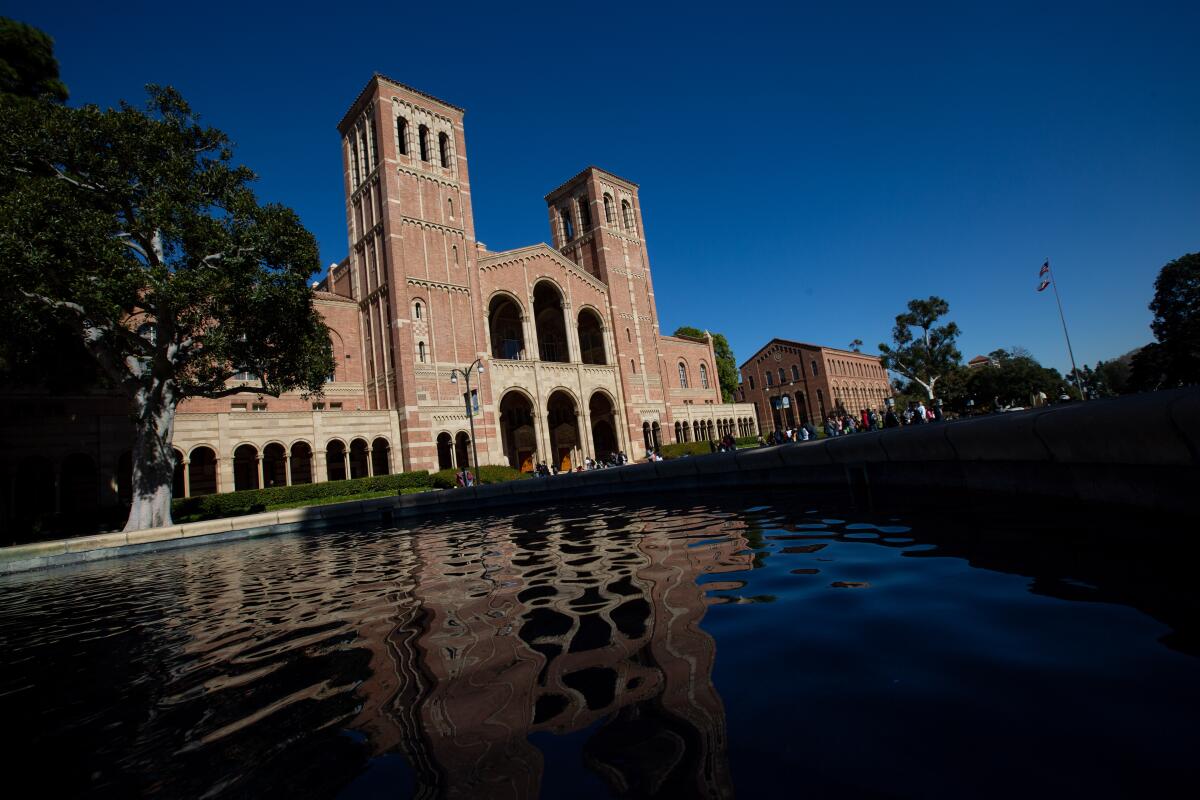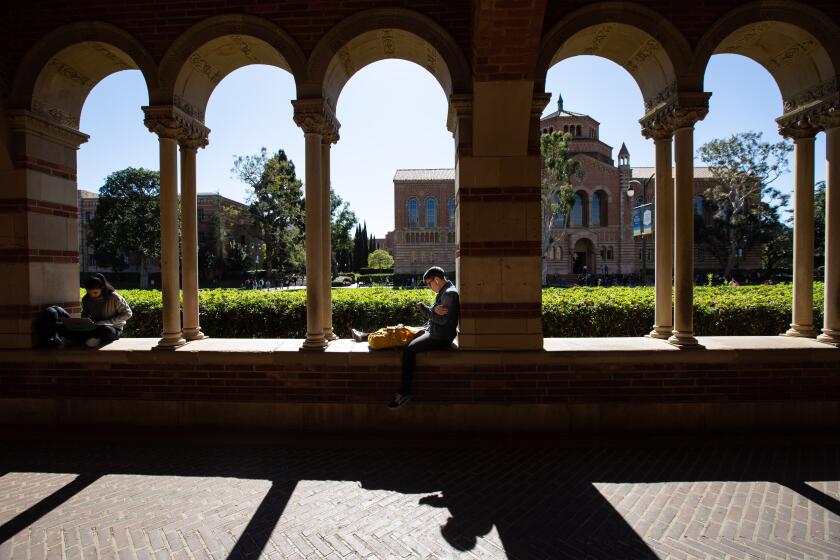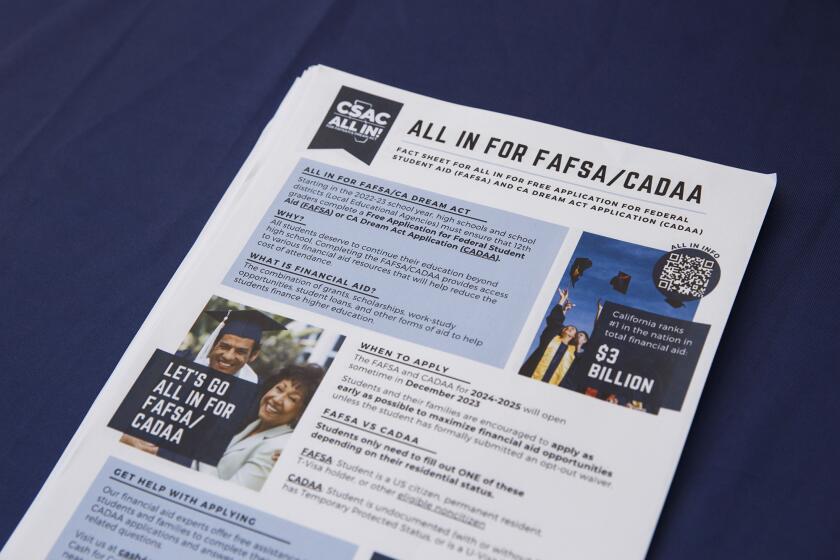UC admits record number of Californians and far fewer out-of-state students

In a revised playbook guiding University of California admissions, the system’s nine undergraduate campuses accepted a record number of California first-year students for fall 2022, while significantly narrowing entry to out-of-state and international applicants amid widespread demands to preserve coveted seats for state residents, according to preliminary data released Wednesday.
The UC system admitted 85,268 California first-year applicants — a 1.2% increase of 1,045 students over last year. Offers to out-of-state applicants declined by 19%, or 5,359 students, and those to international students decreased by 12.2%, or 2,442 students.
Campuses also set records for diversity, as students from underrepresented racial and ethnic groups increased to 43.8% of the admitted first-year class. For the third straight year, Latinos were the largest ethnic group at 37.3%, followed by Asian Americans at 35%, white students at 18.6% and Black students at 5.7%. Overall, both applications and admission offers increased for Latino, Asian American, Black and Native American students and declined among white and Pacific Islander students.
“The University’s enduring dedication to California’s young people and its partnership with the state continue to attract unprecedented numbers of talented Golden State students,” UC President Michael V. Drake said in a statement. “It is our privilege to be able to offer admission to the state’s largest-ever class of California students.”
The rollback in out-of-state and international students represents a significant policy shift years in the making. The public research university system began aggressively recruiting and enrolling higher-paying nonresident students as a source of additional tuition revenue after the 2008 recession when the state slashed its UC funding by one-third.
UCLA and UC Berkeley, for instance, increased the share of nonresidents among undergraduates from about 9.5% in fall 2008 to about 24% in 2021.
The growing number of nonresident students sparked a public outcry and a 2016 state audit, which found that UC admission practices were harming California students. UC sharply disagreed, arguing that the extra nonresident tuition dollars allowed it to pay for more California students and that state budget cuts had forced its hand. Eventually, the state economy recovered, funding for higher education began to rebound, and state elected leaders made clear that UC should boost California student enrollment as their constituents were demanding.
This year, Gov. Gavin Newsom and the Legislature provided $82.5 million to enroll an additional 5,632 California students in 2022 and 2023. That includes $31 million to replace 902 nonresidents with in-state students at UCLA, UC Berkeley and UC San Diego — funding set for annual renewal over at least four more years.
UC admission directors hail the growing access to California students but also note that those from other states and countries greatly enrich the learning and social environment for all.
“It’s important that we do all we can to ensure that California residents have access to a UC campus,” said Youlonda Copeland-Morgan, UCLA vice provost for enrollment management. “But having students learn in classrooms that resemble the state, nation and world enhances their educational experience. It’s a tough balancing act.”
Can brash and bold Arizona State University teach the University of California and California State University how to enroll more resident students with online learning, advanced technology tools and satellite locations — including a swank new L.A. center?
UCLA drew 91,544 first-year applications from California residents for fall 2022, as the campus and UC system shattered their own previous records. The Westwood campus admitted 8,423 of those applicants, an increase of only 54 over last year, but plans to enroll an additional 400 first-year students and about 400 more transfer students. Because more students offered admission are accepting it — about 54% in 2021 compared with 44% in 2011 — UCLA does not need to make as many admission offers to hit its enrollment targets as in the past, Copeland-Morgan said.
Admitted students had near-perfect grades, and UCLA looked for evidence that they had taken full advantage of the opportunities available to them to stretch themselves with challenging courses and extracurricular activities, she said.
Five of the nine UC undergraduate campuses admitted fewer California first-year applicants compared with last year in the first round of offers — mainly cautious about overenrolling. After monitoring the number of acceptances, campus officials then sent out additional offers to students on the waitlist.
UC Santa Barbara, for instance, offered first-round admission to 273 fewer California first-year students than last year — but increased its waitlist offers by nearly 700. Among the 2,792 waitlisted students offered admission, 633 accepted. Overall, the campus plans to enroll about 4,000 California students, an increase of about 350 over last year. UCSB hopes to educate some of them off campus in study abroad or Washington D.C. programs or enroll more in summer sessions.
“We couldn’t risk overenrolling even a single student,” said Lisa Przekop, the campus admission director. “We’re at capacity and didn’t want to experience any housing issues.”
Last year, UC Santa Barbara scrambled to house students in hotels after a last-minute crunch in housing requests and shortages of off-campus rentals due to an influx of nonstudents who wanted to work remotely in the scenic coastal city during the pandemic. Przekop said all student housing requests have been accommodated this year.
At UC Irvine, the calculus of admission targets was a bit more complex. Offers to California first-year applicants declined by a few hundred students, or 1.6%, but significantly dropped by 39% for out-of-state students and 37% for international students.
The University of California drew a record number of first-year applications for fall 2022, with gains in all underrepresented groups; transfer applications fell.
Dale Leaman, Irvine’s executive director of undergraduate admissions, said the campus was “trying to be responsive” to the state’s expectations to decrease nonresidents. At the same time, the number of out-of-state students accepting UC Irvine admission offers increased last year and might do so again this year.
“We’re being very careful about overadmitting nonresidents,” Leaman said, adding that Irvine also used the waitlist more robustly this year than in the past. “It’s complicated calculus.”
UC Berkeley faced an unprecedented admissions season marked by a lawsuit and subsequent court ruling that would have forced the campus to slash fall 2022 admission offers by one-third without a state rescue effort. The campus ultimately was able to meet its planned targets, admitting 10,518 California students for fall 2022, about the same as last year, and reducing offers to out-of-state students by about 33% and to international students, by 26%.
Admission rates for California first-year students declined at UC Berkeley to 14.5% this year from 16.9% last year. They dropped even lower at UCLA, to 9.2% from 9.9% during that same period. Systemwide, admission rates for California students declined to 64.4% this year from 65.7% last year.
UC Santa Cruz cut back its admission offers for fall 2022 because it enrolled two large classes of Californians the previous two years, said Michelle Whittingham, associate vice chancellor of enrollment management. The campus expects to enroll about 700 fewer new undergraduates this fall. Although the first-year class was larger than expected because about 250 more computer science majors accepted their admission offer than predicted, that was offset by a smaller transfer class, enabling Santa Cruz to hit its lower enrollment target for new undergraduates.
“We’re really trying to balance access with quality,” she said, noting that the campus faces housing, curricular and classroom constraints.
Whittingham added that Santa Cruz is still trying to increase out-of-state and international students, whose share of undergraduates fell during the pandemic to about 9.2% last fall from 12% in 2019.
UC Davis also admitted fewer students this year, to offset overenrollment last year, according to a campus statement by Robert Penman, executive director of undergraduate admissions. The campus plans to reduce the size of its new fall 2022 class of first-year and transfer students by about 750 but still enrolls the largest number of in-state undergraduates in the UC system.
Davis admitted 21,139 California first-year applicants, an 11% decline over last year, while offers to out-of-state students were down 16.4% and those to international students fell 29% during that same period. The campus increased offers to transfer applicants.
Two campuses with plenty of room for California students are UC Riverside, which admitted 1,600 more applicants, and UC Merced, which increased offers by about 2,000. UC Riverside plans to enroll about 600 more first-year and transfer students this fall than last.
UC San Diego led all campuses in admitting transfer students. Systemwide, however, admission offers to California Community College transfer applicants declined to 25,253 this year compared with 28,453 last year — due to fewer applications from fewer students at the system’s 116 campuses. Several admission directors expressed concern about the declining enrollment, which complicates UC’s obligation to enroll one community college student for every two first-year students.
About 47% of admitted California first-year students are low-income, and 44% would be the first in their families to earn a bachelor’s degree.
More to Read
Sign up for Essential California
The most important California stories and recommendations in your inbox every morning.
You may occasionally receive promotional content from the Los Angeles Times.













